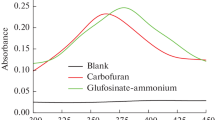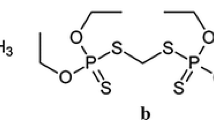Summary
A new spray using DDQ (1,2-dichloro-4,5-dicyanobenzoquinone) for thein situ fluorometric detection of sulfurcontaining pesticides on thin-layer chromatograms was studied in order to evaluate the quantitative potential of the method. The effects of pH, various adsorbents, spray solvents and concentrations, U.V. irradiation and time on the fluorescent intensity of the spots were investigated and the optimum conditions were established. An average reproducibility of 5.0% rel. standard deviation and an average detection limit of 0.05 μg per spot were obtained. Linear calibration curves up to 5.0 μg per spot and extending through the point of origin were observed. This method was used successfully to analyze a natural water sample containing 2 ppb of malathion.
Zusammenfassung
Ein neues Sprühreagenz auf der Basis von DDQ (1,2-Dichlor-4,5-Dicyanobenzochinon), das für diein situ fluorometrische Lokalisierung schwefelhaltiger Pesticide verwendet werden kann, wurde auf sein quantitativ analytisches Leistungsvermögen hin untersucht. Es wird über den Einfluß von pH, Adsorbentien, Lösungsmittel und Konzentration des Sprühreagenzes, U. V.-Bestrahlung und Alterung, auf die Fluoreszenzintensität berichtet. Eine durchschnittliche Reproduzierbarkeit von ungefähr ±5% relativer Standardabweichung und eine instrumentelle Nachweisgrenze von 0,05 μg pro Flecken, bei einem 3∶1 Signal-Rausch Verhältniss, können mit dieser Methode erreicht werden. Durch den Nullpunk gehende lineare Eichkurven (Konzentration gegen Fluoreszenz aufgetragen) wurden bis zu 5 μg pro Fleck beobachtet. Diese Methode wurde mit Erfolg zur Erfassung von 2 ppb Malathion eingesetzt.
Résumé
Un nouveau réactif pulvérisable utilisant le DDQ (1,2-dichloro-4,5-dicyanobenzoquinone) pour la détection fluorométriquein situ de pesticides soufrés sur des chromatogrammes en couche mince a été étudié afin de connaître les possiblités de la méthode du point de vue quantitatif. Les effets du pH, de la nature des adsorbants, des solvants du réactif, des concentrations, de l'irradiation par la lumière U. V. et du temps sur l'intensité de la fluorescence des taches ont été étudiés, et les conditions optimales de révélation ont été déterminées. On a obtenu une reproductibilité moyenne relative de 5,0% comme déviation standard et une limite de détection moyenne de 0,05 μg par tache. Des courbes d'étalonnage linéaires entre 0 et 5,0 μg de substance par tache passant par l'origine ont été obtenues. Cette méthode a été employée avec succès pour l'analyse d'un échantillon d'eau naturelle contenant du Malathion à la concentration de 2 ppb.
Similar content being viewed by others
References
Belliveau, P. E., Frei, R. W., Chromatographia4, 189 (1971).
Kenaga, E. E., Bull. Ent. Soc. Amer.12, 161 (1966).
Askew, J., Ruzicka, J. H., Wheals, B. B., Analyst94, 275 (1969).
Zweig, G., Devine, J. M., Residue Rev.26, 17 (1969).
Author information
Authors and Affiliations
Rights and permissions
About this article
Cite this article
Frei, R.W., Belliveau, P.E. pH-sensitive fluorogenic spray reagents. II. Quantitative studies with pesticides. Chromatographia 5, 296–300 (1972). https://doi.org/10.1007/BF02268589
Received:
Accepted:
Issue Date:
DOI: https://doi.org/10.1007/BF02268589




